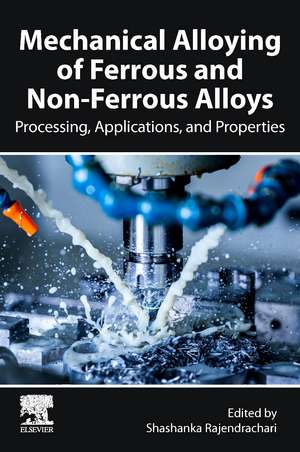Mechanical Alloying of Ferrous and Non-Ferrous Alloys: Processing, Properties, and Applications
Editat de Shashanka Rajendracharien Limba Engleză Paperback – 18 iun 2024
The advantages and disadvantages of wet and dry milling are outlined. Processing, properties, and applications of high entropy alloys, ODS stainless steel, shape memory alloys, cermets, iron, copper, zinc, tungsten, aluminum, titanium, magnesium, and ceramic-based alloys are also covered, as are different powder preparation techniques and sintering methods.
- Outlines the different types of mechanical alloying used to prepare powders, their mechanisms, factors affecting the process, and more
- Covers the manufacturing, characteristics, and applications of high entropy alloys, ODS stainless steel, shape memory alloys, magnesium, ceramic-based alloys, and more
- Compares preparation of ferrous and non-ferrous alloys, their microstructures, and properties
- Discusses the advantages and disadvantages of wet and dry milling
Preț: 1158.65 lei
Preț vechi: 1520.10 lei
-24% Nou
Puncte Express: 1738
Preț estimativ în valută:
221.73€ • 240.77$ • 186.26£
221.73€ • 240.77$ • 186.26£
Carte tipărită la comandă
Livrare economică 15-29 aprilie
Livrare express 15-21 martie pentru 124.82 lei
Preluare comenzi: 021 569.72.76
Specificații
ISBN-13: 9780443161513
ISBN-10: 0443161518
Pagini: 386
Dimensiuni: 152 x 229 x 22 mm
Greutate: 0.63 kg
Editura: ELSEVIER SCIENCE
ISBN-10: 0443161518
Pagini: 386
Dimensiuni: 152 x 229 x 22 mm
Greutate: 0.63 kg
Editura: ELSEVIER SCIENCE
Cuprins
1. Evolution of Mechanical alloying
2. Types of ball milling and their mechanism
3. Overview of the dry milling vs. wet milling
4. Comparative study of mechanical alloying and other conventional powder metallurgical methods
5. Consolidation of mechanically alloyed powders
6. Secondary Processing of Sintered Compacts
7. How mechanical alloying facilitated the fabrication of tungsten heavy alloys
8. Fabrication of Cermets and Copper Alloys by Ball Milling and Investigation of their Properties and Applications
9. Processing of Titanium alloys by mechanical alloying
10. How mechanical alloying facilitated the preparation of intermetallic, ceramic, shape memory alloys, and high entropy alloys?
11. Role of Mechanically Alloyed Materials in Energy Storage and Automotive Applications
12. Current and Future Applications of mechanically alloyed materials
2. Types of ball milling and their mechanism
3. Overview of the dry milling vs. wet milling
4. Comparative study of mechanical alloying and other conventional powder metallurgical methods
5. Consolidation of mechanically alloyed powders
6. Secondary Processing of Sintered Compacts
7. How mechanical alloying facilitated the fabrication of tungsten heavy alloys
8. Fabrication of Cermets and Copper Alloys by Ball Milling and Investigation of their Properties and Applications
9. Processing of Titanium alloys by mechanical alloying
10. How mechanical alloying facilitated the preparation of intermetallic, ceramic, shape memory alloys, and high entropy alloys?
11. Role of Mechanically Alloyed Materials in Energy Storage and Automotive Applications
12. Current and Future Applications of mechanically alloyed materials
